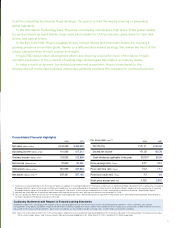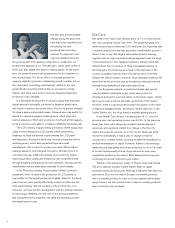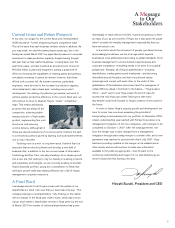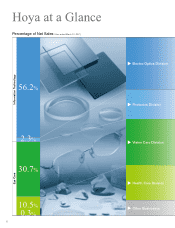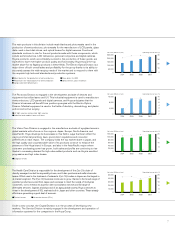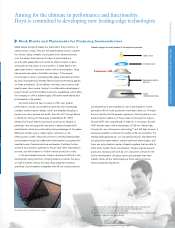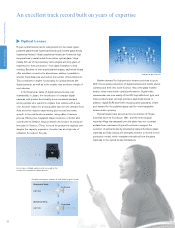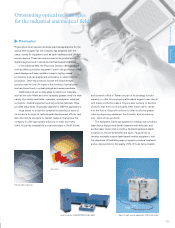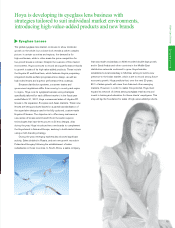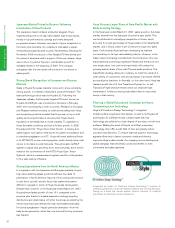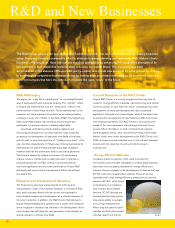Pentax 2007 Annual Report Download - page 12
Download and view the complete annual report
Please find page 12 of the 2007 Pentax annual report below. You can navigate through the pages in the report by either clicking on the pages listed below, or by using the keyword search tool below to find specific information within the annual report.
10
Large-sized LCD photomask (1,220mm x 1,400 mm) used for eighth-generation LCD panels.
Electro-Optics Division
LCD Photomasks
Electro-Optics Division
Hoya’s photomasks are at work behind the scenes,
helping to bring the world larger, higher definition LCD televisions
LCD photomasks are the master plates that are used in the
manufacture of the LCD panels found in large flat televisions and
computer monitors. Hoya is the world’s leading producer of LCD
photomasks, and it has special strengths in the production of
large-scale LCD photomasks.
The major factor in today’s demand for LCDs is the constant
increase in the size of LCD televisions. There is a corresponding
demand for ever larger LCD photomasks. LCD panels are
classified according to their size as fifth-generation,
sixth-generation and so on*1, depending on the size of the
“mother glass” panels used in their mass production. During
2006, LCD panel manufacturers were active in the production of
sixth- and seventh-generation panels, responding to the demand
for larger LCD panels and aiming for greater production efficiency.
There was also a move by some manufacturers to the production
of eighth-generation panels.
In response to the large-scale increase in production by panel
manufacturers, photomask producers also boosted their
production capacity. As a result, declining prices due to growing
competition between manufacturers were clearly witnessed in the
photomask market. Despite this environment, Hoya, by
introducing further improvements to photomask quality, helped
LCD panel manufacturers not only to improve the quality of their
products but also to lower their production costs. Of special note
is the multi-tone mask*2 that Hoya has been able to bring to
fruition through the application of its advanced engineering
strengths. These masks make it possible for panel manufacturers
to reduce costs by realizing around a 20% reduction in the number
of production processes. As another way of differentiating its
products in the market, Hoya is contemplating applying the
technologies it has developed for its higher-precision
semiconductor photomasks in the quality assessment of its
LCD masks.
In the fiscal year ended March 31, 2007, the respective
functions of the Kumamoto (Japan), Taiwan and South Korea
plants were delineated, and Hoya worked to solidify a tripolar
production system. Each plant is located in close proximity to its
client LCD panel manufacturers, enabling Hoya to develop
products that meet the needs of each respective market, and to
shorten delivery times. Hoya is also working to realize further
efficiencies in production processes. These strategies position
Hoya to continue to enhance its competitiveness. Also during the
year, Hoya’s plant in Malaysia commenced production of the mask
blanks that are the substrates for photomasks. Hoya believes that
the application of an integrated manufacturing process—from
mask blanks to photomasks—will add further value to
Hoya’s products.
LCD Photomasks
*1. Panel manufacturers’ mother glass plate sizes:
Fifth-generation: 1,100 mm x 1,300 mm (yielding three 32-inch wide LCD television panels).
Sixth-generation: 1,500 mm x 1,850 mm (yielding eight 32-inch wide LCD television panels).
Seventh-generation: 1,870 mm x 2,200 mm (yielding three 50-inch wide LCD television panels).
Eighth-generation: 2,160 mm x 2,400 mm (yielding six 50-inch wide LCD television panels).
*2. A photomask that allows for mid-range light penetration through pattern shrinkage and semitransparent film.



